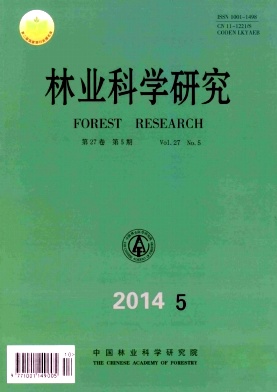Selection and Growth Potential Analysis of Chinese Fir Clones
-
Received Date:
2013-10-20
-
Abstract
Three groups of Chinese fir (Cunninghamia lanceolata) clone test stands, designed by stem, line and block assignments, were established at Huitong county and Suilning county of Hunan province in 1983, 1986 and 1997, respectively, including 33 clones and 2 contrasts. Base on three survey data (ranging from 4 to 31 years old), the variance analysis was used in the study. The results showed that significantly different existed in the diameter and height growths among the young-aged (4-7 years), the middle-aged (13 to 16 years) and mature (28-31 years) stands. Different clones followed different process of growth. Some clones grew slowly in young age period, fast in middle-aged period, and steadily in mature period. Two excellent clones still kept the earlier growth dominance in 31 years old, and their growth always showed good while planted at the 18 m site index or 16 m site index, their diameters and heights ranked the first and the second. The growth of the two excellent clones had temporal and spatial stabilities at certain extents. In block afforestation conditions, the tree height, DBH growth and volume per unit area of 13-year-old excellent clones were 20.1%~26.6%, 27%~31.1%, and 78.7%~92.8% higher than that of the check.
-

-
References
|
[1]
|
吴中伦. 杉木[M]. 北京: 中国林业出版社,1984.
|
|
[2]
|
黔东南州杉木遗传改良协作组.杉木无性系测定初步研究[J]. 贵州林业科技, 1999,27(4): 14-17.
|
|
[3]
|
张建国. "九五"国家攻关专题杉木建筑材树种遗传改良及大中径材培育技术研究报告[D]. 北京: 中国林业科学研究院.,2000.
|
|
[4]
|
广东省杉木无性系选育协作组.广东省杉木无性系选育研究[J]. 广东林业科技,2003,19(3):1-5.
|
|
[5]
|
张贵云,王 欣.贵州省杉木无性系材性选择技术研究[J].种子,2008,27(2):72-74.
|
|
[6]
|
肖复明,刘祥凤.灰色系统理论在杉木无性系综合选择中的应用[J].林业实用技术,2008(2):6-8.
|
|
[7]
|
赖银华.闽南杉木优良无性系选择[J].林业科技开发,2004,18(4):35-36.
|
|
[8]
|
来 端.杉木无性系不同规格苗木造林对幼林生长影响的研究[J].林业科技通讯,2000(10):7.
|
|
[9]
|
杨修立.杉木无性系不同选择时间的效果分析[J].湖南林业科技, 2002,29(2):80-81.
|
|
[10]
|
肖石海.杉木无性系测定及速生优良无性系选择[J].福建林学院学报,2005,25(4): 349-351.
|
|
[11]
|
林 敏.杉木无性系测定与选择[J].林业科技开发,1998(5):12-13.
|
|
[12]
|
游水林.杉木无性系的遗传变异及优良无性系选择[J].四川林业科技,2001,22(2):60-64.
|
|
[13]
|
黄开勇,陈代喜.杉木无性系对比测定与选择[J].西南林学院学报, 2008,28(6):25-29.
|
|
[14]
|
周天相.杉木无性系改良增产效益的研究[J].林业科技开发,1997(2):11-14.
|
|
[15]
|
陈端吕.杉木无性系家系造林早期选优研究[J].湖南林业科技,2004,23(1):23-24.
|
|
[16]
|
江祖森.杉木无性系林选择效果分析[J].广东林业科技,1996,12(3):14-17.
|
|
[17]
|
张文峤.杉木无性系区域化试验的初步研究[J].广西林业科学,1996,25(4):202-205.
|
|
[18]
|
张金文.杉木无性系区域造林试验初报[J]. 华东森林经理,1996(10):50-54.
|
|
[19]
|
张孟德.杉木无性系生长表现和优良无性系选择[J].湖南林业科技, 2010,37(3):6-8.
|
|
[20]
|
胡德活.杉木无性系木材密度遗传变异及其与生长性状的相关性[J].中南林学院学报,2004,24(5):24-26.
|
|
[21]
|
许忠坤.杉木无性系木材尺寸稳定性研究[J].湖南林业科技,2010,37(5):20-21.
|
|
[22]
|
南京林产工业学院树木育种组.杉木早期选种初步研究[J].遗传学报,1976,3(2):128-136.
|
|
[23]
|
叶培忠,陈岳武.杉木早期选择的研究[J]. 南京林产工业学院学报,1981(1):106-115.
|
|
[24]
|
张全仁,许忠坤.杉木速生性早期预测的研究[J]. 中南林学院学报,1983,3(2):113-121.
|
|
[25]
|
马常耕.杉木无性系生长的遗传控制和早期选择初探[J]. 林业科学,2000,36(1):62-69.
|
-
-
Proportional views

-





 DownLoad:
DownLoad: